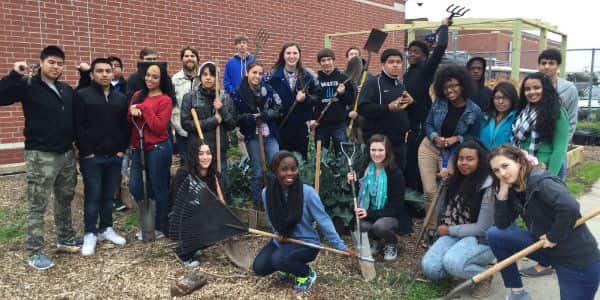One way to teach kids about ecosystems is to let them build their own. That’s what students at Westside High School did. Their 80-gallon indoor aquaponics system supports the growth of plants and fish together, providing academic and life lessons on a constant loop.
In an aquaponic system, the waste produced by farmed fish supplies nutrients for plants (often tomatoes or lettuces) grown hydroponically, and the plants in turn help to purify the water for the fish to thrive. The system can be built indoors or outdoors, and either way it provides a hands-on learning tool for a wide range of science topics in biology, chemistry and more. It also offers practical lessons in mechanics, engineering, research and problem-solving.
“There’s a lot of plumbing and physics involved, and once you get the system set up you’re monitoring water chemistry, ammonia, pH, nitrates and nitrites,” explains Westside High School Garden Educator and Science Teacher Lawrence Spence. “This nitrogen cycle is relevant to all living things. When I teach the nitrogen cycle on paper, it’s boring, but this system makes it real. Our aquaponics system is a living teaching tool, as well as a functional thing that grows food.”
Mostly using repurposed materials, Lawrence and his students built a type of indoor aquaponics system called a raft system.
“We pulled together resources we had at the school: a fish tank we had on hand, a light fixture, some lumber,” Lawrence says. “We scrounged in our garages. Someone had an aquarium pump.”
The mechanics of the system are fairly simple: Water gets pumped up and out of one fish tank on the floor into another fish tank on a stand raised four feet above the floor. The water then overflows into a trough-like grow bed, in which tomatoes grow in an expanded-clay medium. The water in this trough is controlled by a bell-siphon, which drains into a second trough where vegetables, such as lettuces, grow on a Styrofoam raft. The vegetable roots dangle into the water, and this trough then overflows into the first fish tank on the floor. Air diffusers keep the water constantly aerated to prevent root rot.
Lawrence considers this first indoor system a prototype, and has big plans for an outdoor system, which will be much larger and designed to grow vegetables with tilapia and catfish. The plan is to build it from 1,000-liter, food-grade IBC totes. With just a few simple modifications, these plastic cube containers can be made into a grow-bed-and-tank-in-one, then plumbed in and an aerator added to keep the water moving.
“Because the system will be larger, it will be easier to manage. Changes are amplified in a small system. A large system is more forgiving,” Lawrence explains.
The planning phase for this next system is providing a new crop of students with research experience, not to mention practice with time and project management, budgeting and other skills.
“There are a lot of videos and instructional materials online that show various permutations of how you can build these systems,” Lawrence says. “We’re spending a lot of time outside class on this stuff. It’s part of the kids’ grades to gather materials. We’ve visited farms to find ideas.”
The next phase also will involve a deeper investigation into sustainable food alternatives for the fish.
“Aquaponics is a great step toward food security for our communities,” Lawrence explains. “But currently the model is to use conventional fish food, which may contain soy, corn, wheat or even chicken byproduct. Fish were not designed to eat corn and soy, and I don’t want to eat a sick fish. We’re trying to tinker with creating an alternative, so we don’t have to use commercially prepared fish food.”
“Aquaponics is a great step toward food security for our communities.”
For their first foray into a sustainable fish food supply, they’ll try growing mosquito fish and duckweed, a native plant that thrives on top of ponds. Lawrence hopes to build troughs on school grounds to grow the duckweed and use compost to provide the nutrients for the duckweed. He and the students also will experiment with feeding vegetable scraps to the tilapia.
“Hopefully we can use some of our cafeteria waste,” he explains. “Tilapia are omnivores, and we’d like to come up with a model for creating food with locally sourced materials.”
There are pros and cons to both indoor and outdoor aquaponics. Besides space limitations, growing indoors can get expensive due to the need for lighting and electricity, but allows for more control over environmental variables.
Outdoor growing is usually less expensive and more energy efficient, but climate or site placement may be a concern. Some fish species are sensitive to water temperature, so direct sun can create challenges, and outdoor systems may need to be heated or insulated in colder locations.
For more information about aquaponics and to determine whether it’s right for your school garden program, start with these resources:
- Search for how-to videos on YouTube.
- Check with your county extension agency for locally and regionally specific aquaponics resources and recommendations.
- Hydroponic farms or retailers that supply them also are a great resource.
- Visit the farmer’s market and build connections with people involved in the local food scene. Chefs, restaurant owners and suppliers may be able to put you in touch with aquaponics or hydroponic farms in your area.



